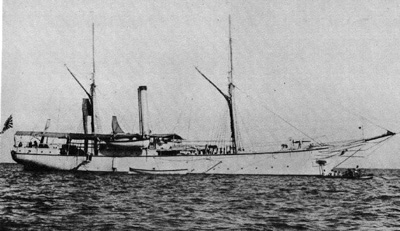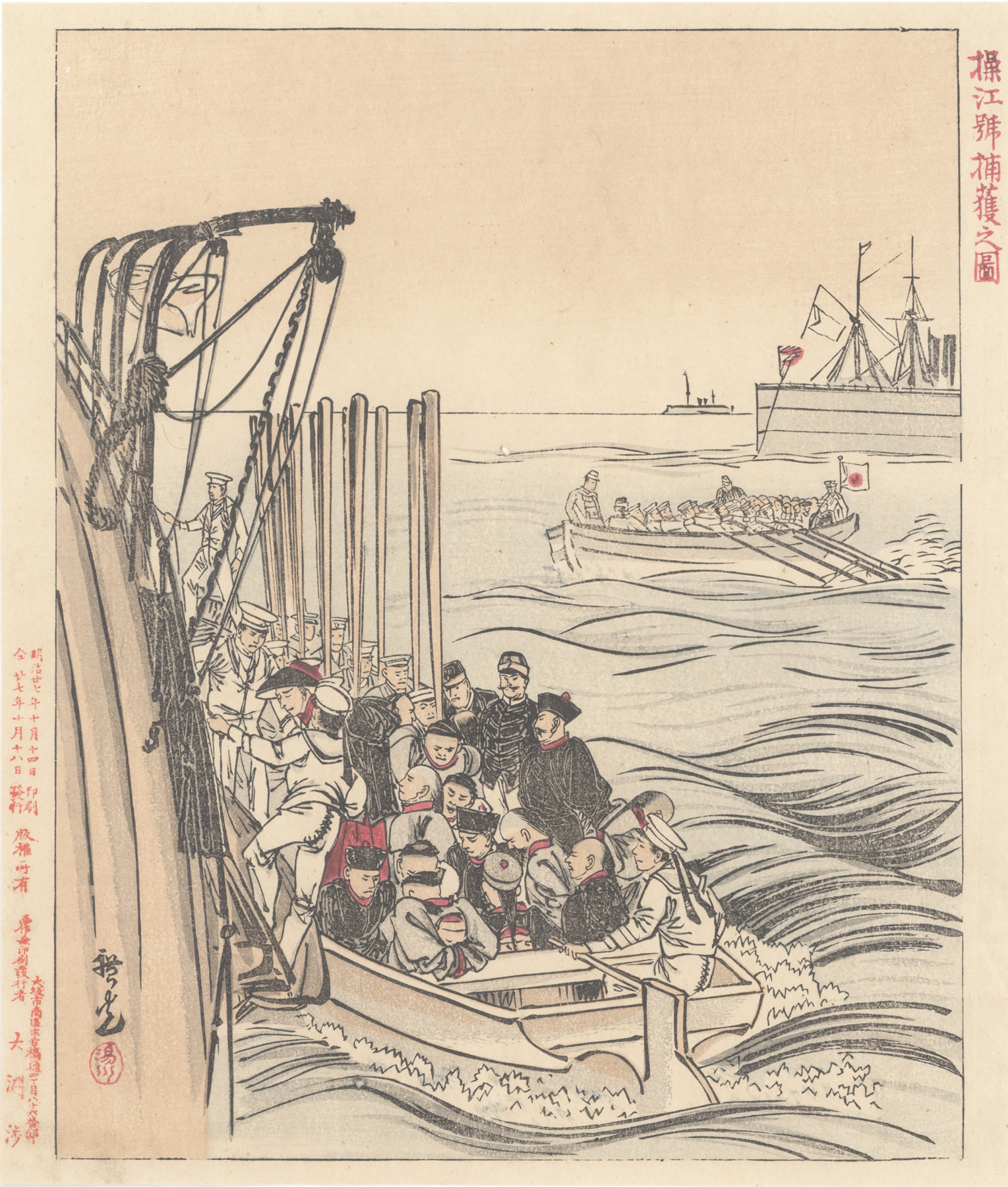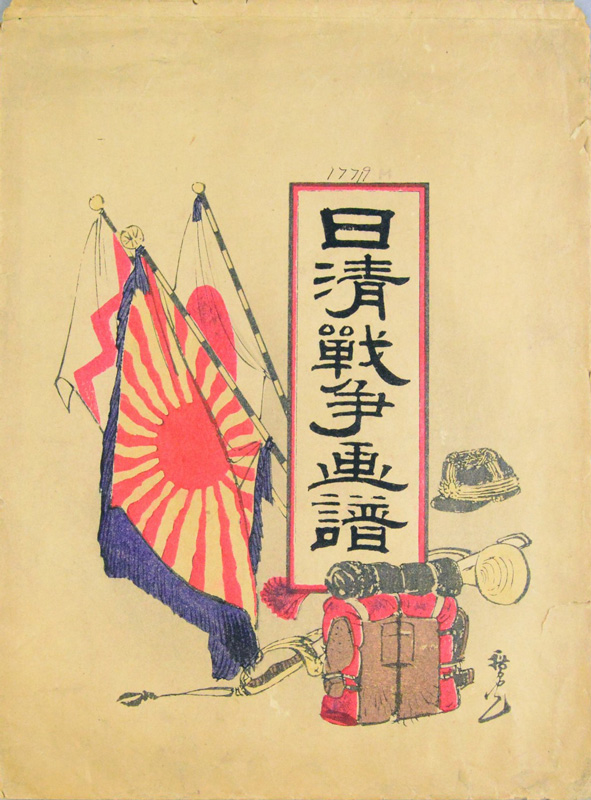About This Print
A depiction of captured Chinese sailors from the gunboat Tsao Kiang (Caojiang) which was captured off Asan, Korea by the Japanese cruiser Akitsushima on July 27, 1894 during the Battle of Pungdo, the first naval battle of the Sino-Japanese War (1894-1895). The sailors are likely being transferred to the Japanese dispatch vessel Yayeyama1. Conflicting information exists on the history of the Tsao Kiang and also its renaming as a ship of the Japanese navy, with most sources (including the title of this print) listing its new Japanese name as "Sōkō" and at least one source listing its new name as the "Toyshina." The wikipedia entry on this ship follows.
This print, as opposed to almost all other Sino-Japanese War prints, was published in Ōsaka rather than in Tokyo. Its publisher Ōbuchi Wataru of the publishing house Hatsubai Shinshindō was primarily a book publisher and this print was part of a twelve print gafu (picture book), a portfolio titled Sino-Japanese War Picture Book, the envelope for which is shown below.
Envelope for the series Sino-Japanese War Picture Book
image source: Penn Museum 17719M
1 The Surgical & Medical History of the Naval War Between Japan & China During 1894-95 , S. Suzuki of the Imperial Japanese Navy, Tokio Printing Co., Ltd., 1901, p. 534.
The Captured Ship Tsao Kiang
Source: Wikipedia http://en.wikipedia.org/wiki/Chinese_gunboat_Tsao-kiang
Tsao Kiang (traditional Chinese: 操江; pinyin: Cāojiāng) was a 640-ton wooden (according to other sources: 600-ton composite-hulled) gunboat, launched in 1869 by Jiangnan Shipyard, Shanghai, for the Nanyang Fleet. Acquired in 1872 for Zhili by Li Hongzhang it served with Beiyang Fleet as a governor's yacht. It was captured by the Japanese cruiser Akitsushima on 25 July 1894 during the Battle of Pungdo and was renamed Soko; stricken in 1902, it was broken up in 1904.

Imperial Japanese Navy gunboat Soko in 1897
http://en.wikipedia.org/wiki/File:IJN_gunboat_SOKOU_in_1897.jpg
http://en.wikipedia.org/wiki/File:IJN_gunboat_SOKOU_in_1897.jpg
The Battle of Pungdo (豊島沖海戦)
Source: Wikipedia http://en.wikipedia.org/wiki/Battle_of_PungdoThe Battle of Pungdo or Feng-tao (Japanese: 豊島沖海戦) was the first naval battle of the First Sino-Japanese War. It took place on 25 July 1894 offshore of Asan, Chungcheongnam-do Korea between cruisers of the Imperial Japanese Navy of Meiji Japan and components of the Beiyang Fleet of Qing China.
The Japanese Account
Source: http://www.okazaki-inst.jp/mutsu_munemitsu/Mutsu_Chapter_16.pdf, p. 1, 2.
In the early morning of July 25, 1894, the cruisers Yoshino (吉野), Akitushma (秋津州), and Naniwa (浪速) of the First Mobile Squadron of the Japanese Grand Fleet encountered the Qing navy cruiser Tsi-yuan (済遠) and the gunboat Kwang-yi (広乙) in the offing of Pungdo Island off the west coast of the Korean peninsula. While ordering crews to prepare for action in case of emergency, the commander of this tiny Japanese fleet intended to sail past the Qing ships in accordance with naval procedure in peacetime. When the distance between the two fleets narrowed to 3,000 meters, however, the Tsi-yuan suddenly started firing at the Yoshino; the Japanese fleet immediately returned fire. Thus began a fierce exchange of salvos. Visibility soon worsened due to funnel smoke of the warships and their gun smoke mixed with the morning mist.
When the mist cleared, the Kwang-yi was adrift, deprived of any battle capability, while the Tsi-yuan was fleeing. Chased by the Naniwa, the Tsi-yuan soon hoisted the white flag and the ensign of the Rising Sun to signal the surrender. At that point, the British commercial ship Kow-shing (高陞) arrived on the scene. The Kow-shing was transporting Qing soldiers and was escorted by the Chinese gunboat Tsao-kiang (操江). The Tsao-kiang immediately surrendered, but while the Naniwa’s crews boarded and searched the Kow-shing the Tsi-yuan fled. When ordered to tag along with the Naniwa, the British captain of the Kow-shing agreed to comply, but Qing soldiers on board stubbornly insisted on being taken back to a Qing port because the war had not yet erupted when the Kow-shing left Qing. After four hours of futile arguments, Tōgō Heihachirō (東郷平八郎), commanding officer of the Naniwa, issued the last warning and, subsequently, sank the Kow-shing and its crew members and soldiers, sparing the lives of three officers, including the captain.
last revision:
The Japanese Account
Source: http://www.okazaki-inst.jp/mutsu_munemitsu/Mutsu_Chapter_16.pdf, p. 1, 2.
In the early morning of July 25, 1894, the cruisers Yoshino (吉野), Akitushma (秋津州), and Naniwa (浪速) of the First Mobile Squadron of the Japanese Grand Fleet encountered the Qing navy cruiser Tsi-yuan (済遠) and the gunboat Kwang-yi (広乙) in the offing of Pungdo Island off the west coast of the Korean peninsula. While ordering crews to prepare for action in case of emergency, the commander of this tiny Japanese fleet intended to sail past the Qing ships in accordance with naval procedure in peacetime. When the distance between the two fleets narrowed to 3,000 meters, however, the Tsi-yuan suddenly started firing at the Yoshino; the Japanese fleet immediately returned fire. Thus began a fierce exchange of salvos. Visibility soon worsened due to funnel smoke of the warships and their gun smoke mixed with the morning mist.
When the mist cleared, the Kwang-yi was adrift, deprived of any battle capability, while the Tsi-yuan was fleeing. Chased by the Naniwa, the Tsi-yuan soon hoisted the white flag and the ensign of the Rising Sun to signal the surrender. At that point, the British commercial ship Kow-shing (高陞) arrived on the scene. The Kow-shing was transporting Qing soldiers and was escorted by the Chinese gunboat Tsao-kiang (操江). The Tsao-kiang immediately surrendered, but while the Naniwa’s crews boarded and searched the Kow-shing the Tsi-yuan fled. When ordered to tag along with the Naniwa, the British captain of the Kow-shing agreed to comply, but Qing soldiers on board stubbornly insisted on being taken back to a Qing port because the war had not yet erupted when the Kow-shing left Qing. After four hours of futile arguments, Tōgō Heihachirō (東郷平八郎), commanding officer of the Naniwa, issued the last warning and, subsequently, sank the Kow-shing and its crew members and soldiers, sparing the lives of three officers, including the captain.
Print Details
| IHL Catalog | #570 and #2429 |
| Title or Description | Illustration of the Capture of the Gunboat Sōkō 操江号捕獲の圖 Sōkō-gō hakaku no zu |
| Series Title | Sino-Japanese War Picture Book 日清戦争画譜 Nishin sensō gafu |
| Artist | Yukawa Hiromitsu (active c. 1894) |
| Signature |  |
| Seal | Yukawa 湯川 (see above) |
| Publication Date |  |
| Publisher | Ōbuchi Wataru 大淵涉 of the Ōsaka 大阪 publishing house Hatsubai Shinshindō 發賣駸々堂 [click on image to enlarge] |
| Impression | IHL Cat. #570: excellent IHL Cat. #2429: excellent |
| Colors | IHL Cat. #570: excellent IHL Cat. #2429: excellent |
| Condition | IHL Cat. #570: fair - overall soiling IHL Cat. #2429: good - minor soiling; small hole center of image |
| Genre | ukiyo-e; senso-e |
| Miscellaneous | |
| Format | shikishiban |
| H x W Paper | IHL Cat. #570: 10 1/8 x 8 5/8 in. (25.7 x 21.9 cm) IHL Cat. #2429: 9 5/8 x 8 1/4 in. (24.4 x 21 cm) |
| H x W Image | IHL Cat. #570: 9 3/16 x 7 7/16 in. (23.3 x 18.9 cm) IHL Cat. #2429: 9 3/16 x 7 7/16 in. (23.3 x 18.9 cm) |
| Literature | |
| Collections This Print | Penn Museum, University of Pennsylvania 17719H |
4/9/2021
4/27/2020




